We hope you have a snack nearby because you might get a little hungry reading this. What do Italians eat for breakfast? The answer might surprise you. Unlike the hearty, savory breakfasts common in the United States, an Italian breakfast—colazione—is typically light, simple, and often sweet. Think pastries, biscuits, or even cake, paired with a strong espresso or cappuccino. You won’t find massive brunch plates or stacks of bacon and eggs. Instead, breakfast in Italy is quick and casual—often enjoyed standing at the bar of a local coffee shop while chatting with friends before starting the day. Let’s dive into what makes an authentic Italian breakfast!
First up, coffee. A typical Italian breakfast, at the very least, includes a caffe latte or a cappuccino. Children typically drink hot chocolate, plain milk, or even hot milk with a dash of coffee. An alternative to coffee is Orzo, a slightly nutty, non-caffeinated roasted barley beverage that looks like cocoa. But let’s be honest, espresso is the way to go.
The ideal accompaniment to your coffee is bread or rolls with butter and jam, biscotti, or a pastry. At home breakfast options include, muesli and yogurt, cookies, croissants, and fruit. Breakfast in Italy might not be the healthiest, but it sure is delicious. You probably won’t see things like cereal and muffins. Definitely no eggs for breakfast; those are reserved for lunch, in hard-boiled form on salads.
Unlike in most parts of the world, breakfast in Italy isn’t a huge meal. Italians simply aren’t heavy breakfast eaters. Eggs, sausages, and pancakes baffles an Italian. How can one eat such a big meal with a long day ahead of them? Anything to filling would just tire them out before a busy work day. Even on weekends and holidays, people generally don’t go out for a sit down breakfast. And while espresso is served all day long, it’s uncommon to see someone eating a croissant in the afternoon. Bars tend to run out of pastries early, as they are freshly baked in the morning.
Why Breakfast in Italy Is All About Simplicity
Unlike in many cultures where breakfast is a big, hearty meal, Italians take a different approach. What do Italians eat for breakfast? It’s all about simplicity, flavor, and ease. Italians see breakfast as a quick, light start to the day—just enough to wake up and get going. The real star of the Italian dining experience is lunch, which is typically the largest and most elaborate meal of the day. Breakfast, on the other hand, is meant to be fast, satisfying, and enjoyable without being too filling.
This is why most Italians don’t sit down for a heavy morning spread. Instead, they grab a coffee and a pastry at the counter of their favorite bar (café), enjoy a quick chat with the barista or friends, and then head off to start the day. There’s no rush, but there’s also no bacon, eggs, or stacks of pancakes. It’s a ritual based on quality rather than quantity—something delicious, simple, and comforting.
Now, let’s take a look at what exactly makes up a typical Italian breakfast and how you can enjoy it at home.
So What Do Italians Eat for Breakfast and How to Prepare Them?
Preparing a typical Italian breakfast requires some specific ingredients and preparation methods. Here’s a simple guide on how to prepare it:
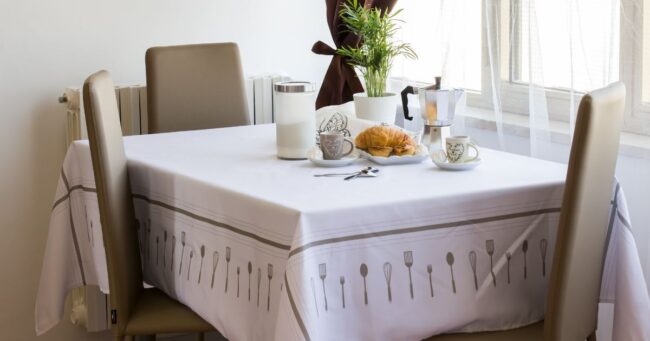
Cappuccino or Espresso:
For Espresso: If you have an espresso machine, simply prepare your espresso according to your machine’s instructions. Remember that Italian espresso is strong and served in small quantities.
For Cappuccino: Make an espresso shot as above. Meanwhile, heat some milk (about twice the volume of your espresso) without letting it boil, then froth it until it forms a thick foam. Pour the hot milk into your espresso, holding back the foam with a spoon, then spoon the foam on top.
Cornetto:
If you are not in Italy, it might be challenging to find a real Italian cornetto in your local bakery, but a French croissant is a good alternative. You can also try making them at home if you have time and baking skills.
If you are lucky enough to find them, you can heat them slightly in the oven before serving. Fill them with a small amount of jam, cream, or chocolate if they’re plain and you prefer them filled.
Biscotti:
Biscotti can be bought from many supermarkets and Italian delis. There are different varieties to choose from, depending on your preference.
Serve them on a plate next to your coffee. They are usually enjoyed by dipping them into the coffee.
Tartina:
Toast a slice of bread until it’s golden and crispy. Spread a layer of butter (optional) and then a layer of your favorite jam or Nutella.
Fette Biscottate:
These are also widely available in stores. Toast them lightly if needed, and serve with a side of butter and jam or Nutella.
Fresh Fruit:
Choose a variety of fresh seasonal fruits. Rinse, peel (if necessary), and cut into slices or bite-size pieces.
Yoghurt:
Serve plain or fruit yoghurt in a bowl. If you want, you can add some granola or fresh fruits on top.
Pane, Burro e Marmellata:
Simply toast slices of your favorite bread, apply a spread of butter, and add a layer of marmalade or jam on top. This is best served warm.
Ordering Italian Breakfast in a Restaurant
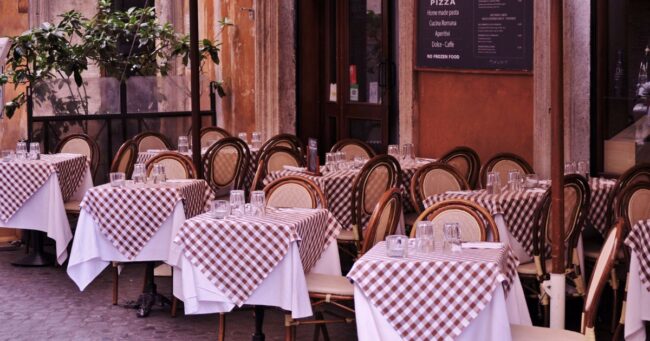
Ordering breakfast in an Italian restaurant or café (known as “bar” in Italy) can be an interesting experience. Here’s how to order a typical Italian breakfast:
Knowing What to Order: A typical Italian breakfast usually consists of a coffee and a pastry. The coffee could be a cappuccino, espresso, or caffè latte, and the pastry could be a cornetto (an Italian croissant), biscotti, or a slice of a simple cake. Sometimes, you might find a tartina (bread with jam or Nutella) or fette biscottate (toast with butter and jam).
Ordering Your Coffee: Start by ordering your coffee. If you want a cappuccino, you could say “Un cappuccino, per favore” (One cappuccino, please). If you prefer an espresso, you can say “Un espresso, per favore.” Remember, “latte” alone means milk in Italian, so if you want a milk coffee, make sure to order a “caffè latte”.
Ordering Your Pastry: To order your pastry, you could say “Un cornetto, per favore” (One cornetto, please). If the pastries are visible and you’re not sure what a particular pastry is, you can point and ask “Cos’è quello?” (What is that?).
Sitting or Standing?: Remember, in many Italian bars, prices are different depending on whether you’re standing at the counter or sitting at a table. Standing at the counter is cheaper and more typical for locals grabbing a quick breakfast. If you prefer to sit, you can ask “Posso sedermi?” (May I sit?). Note that the waiter might reply with the different pricing for sitting down.
When to Pay: In many places, you’ll pay at the end, but in some bars, you pay first, get a receipt, and then order at the counter. When in doubt, observe what others are doing or ask “Pago ora o dopo?” (Do I pay now or later?).
Don’t Forget: It’s not customary to leave a tip in Italian bars, but if you sit at a table and receive table service, it is appreciated.
Fun Facts About Italian Breakfast
Do you ever wonder, what do Italians eat for breakfast beyond a classic cornetto and cappuccino? Italian breakfast traditions are full of charming quirks that make mornings in Italy unique.
Italian Breakfast is Sweet: Unlike many other cultures where breakfast may include savory items, an Italian breakfast, or “colazione”, is typically sweet, with pastries, biscuits, and sweetened coffee being standard fare.
No Eggs, No Bacon: Unlike American or English breakfasts, Italians don’t commonly eat eggs, bacon, or any other meat for breakfast. If you ask for an “English breakfast” in Italy, you might get some puzzled looks!
Coffee Rules: Italians take their coffee very seriously, and breakfast is no exception. Whether it’s an espresso, macchiato, or cappuccino, coffee is a vital part of the Italian breakfast ritual. Just remember not to order a cappuccino after 11 a.m.; many Italians believe that milk can hinder digestion at later hours.
Standing Up Breakfast: Particularly in big cities, it’s common for Italians to have breakfast standing at the counter of a local bar or café. It’s a quick in-and-out experience – have your coffee, enjoy your cornetto, and then be on your way.
Bread and Chocolate: “Pane e Nutella” (bread and Nutella) is a beloved breakfast item, particularly among Italian kids. The famous hazelnut-cocoa spread was actually invented in Italy, and Italians consume a significant amount of the world’s Nutella each year!
Late Breakfasts Are Rare: Unlike brunch culture in many other parts of the world, late breakfasts are not common in Italy. Most Italians have breakfast early in the morning before starting their day’s activities.
Regional Variations: While the sweet, simple breakfast is typical across Italy, there are regional variations. For example, in Northern Italy, it’s more common to have a small roll of bread with butter and jam. In contrast, in Sicily, you might find people enjoying a “Granita” (a semi-frozen dessert) and brioche for breakfast, particularly in the warmer months.
Typical Italian Breakfast by Region
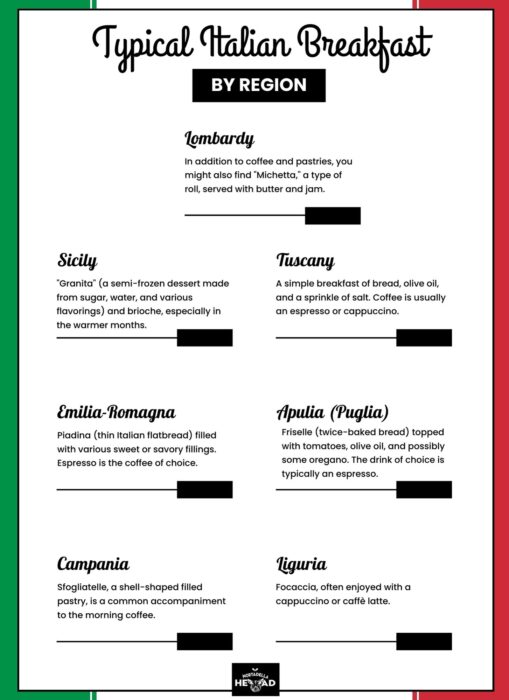
Remember that these are generalizations and variations exist even within these regions. Many Italians, no matter where they live, enjoy a simple breakfast of coffee and a sweet pastry or biscuit. The items listed above are additional regional specialties you might encounter.
Italian Breakfast FAQs:
Why Italians Don’t Eat a Big Breakfast?
Italians prefer a light breakfast because lunch is traditionally the biggest meal of the day. A heavy breakfast would make it harder to enjoy a multi-course lunch, which is central to Italian dining culture.
Why Do Italians Drink Warm Milk & Barley Coffee for Breakfast?
Barley coffee (caffè d’orzo) is a caffeine-free alternative to espresso, often enjoyed by children or those avoiding caffeine. Warm milk is commonly paired with it for a comforting, easy-to-digest morning drink.
What’s the Difference Between Italian and French Breakfasts?
Both are light and sweet, but Italians prefer cornetti (softer and sweeter than croissants) with coffee, while the French often have buttered baguettes or croissants with jam. Italian breakfast is usually eaten standing at a café, whereas the French may take their time at home.
Do Italians Ever Eat Savory Breakfasts?
While sweet breakfasts dominate, some Italians, especially in rural areas, might eat bread with cheese or cured meats. However, this is rare and more common for brunch or a mid-morning snack.
What Time Do Italians Eat Breakfast?
Most Italians have breakfast early, between 7:00 and 9:00 AM, before heading to work or school. Unlike in other cultures, breakfast is quick, often lasting just a few minutes at a café counter.
Start Your Morning the Italian Way
Do You Still Ask the Question: What Do Italians Eat for Breakfast?
Now you have the answer! Whether it’s a flaky cornetto with espresso at a café or a homemade slice of ciambellone, breakfast in Italy is all about simplicity and flavor. So why not start your day the Italian way? Skip the heavy plates, grab a sweet bite, and enjoy your morning with a perfectly brewed coffee—just like they do in Italy.
And there you have it! An authentic Italian breakfast. Don’t forget to take your time and enjoy each bite with a sip of your coffee or tea, as the Italians do.
To put it simply, breakfast in Italy = hot beverage + pastry. Now you’ll just have to choose which sweet you’ll start your day with…
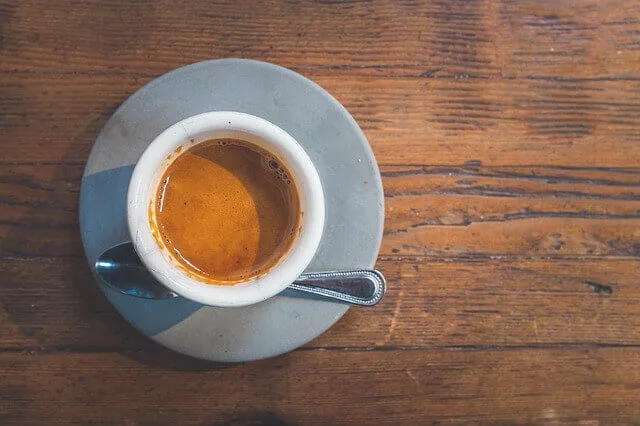





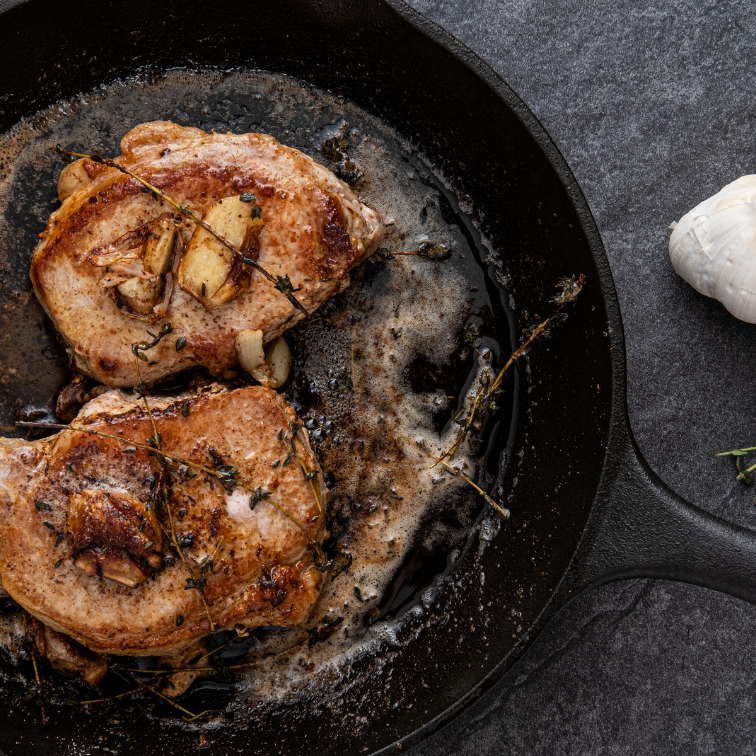
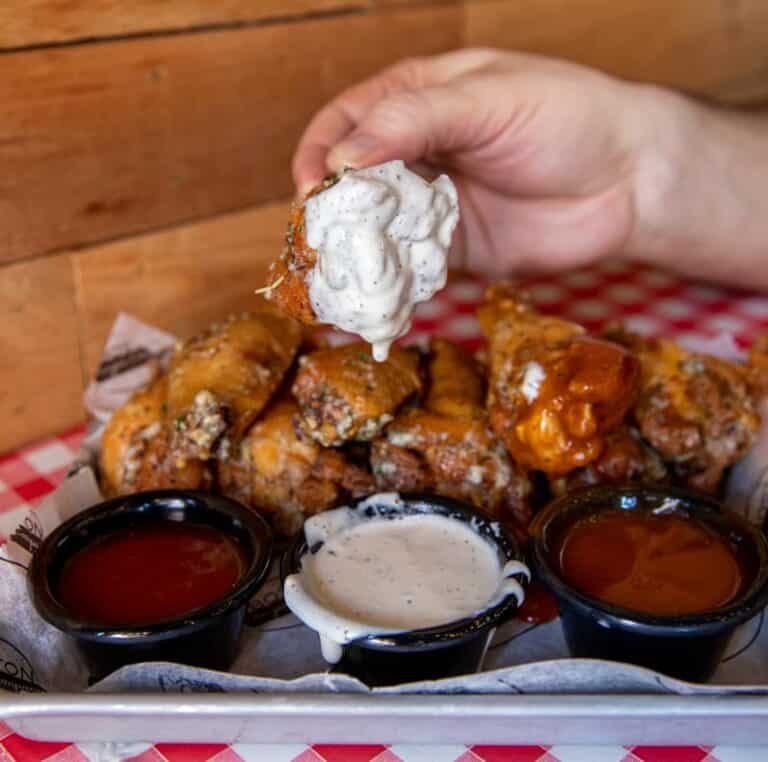

2 Responses
Italy is not much of brekfast country.We usually have very light, sweet breakfasts.COFFEE,MILK,CARBS,SUGAR is our most common breakfast.Thanks for sharing this info.